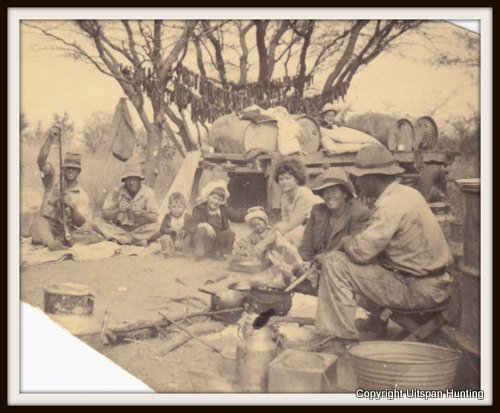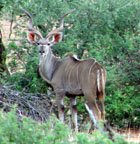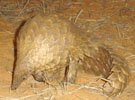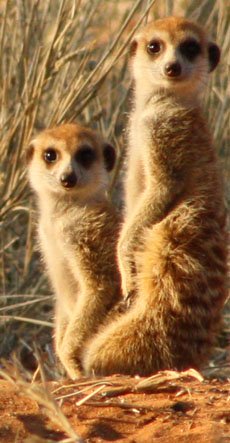For more information about our hunting safaris, don’t hesitate to reach out and contact us!
Kalahari Springbok
by Stephan Hofmann
(Illinois,USA)
We were watching South African Rugby on Hendrik's TV. Hendrik was enthused also about the game. A group of large men were pushing and blocking each other and handing an oblong ball to each other as they moved it down the field. The game of Rugby was new to me, but it seemed to be an exciting and physical game. I believe the American game of football evolved from Rugby.
While we watched the Rugby game we enjoyed fresh and thick cut dried beef. Delicious. I believed they call it Biltong and the Afrikaans people enjoy it with fat on it.
I was at Hendrik's house on Uitspan Ranch in the Kalahari of Namibia. Hendrik and his wife Isabelle owned the farm and raised Karakul sheep as well as offered plains game safaris to clients from all over the world. It was a special occasion this day for it was the birthday of one of Neil's daughters. Neil was Hendrik's son-in-law. All the beautiful children were dressed up in pretty pastel colors and had flowers in their hair. They looked angelic as they ate their cake and opened their special presents. As I watched the children I felt as if I had been transported back to the 60's when love was in the air and people wore flowers in their hair.
The Kalahari so far had been a paradise on earth; a heaven for all who lived here. No smog, traffic, pollution or crime.
After the birthday party we decided to go back to the hunting camp near Botswana for the night. Young Jan-Hendrik, about seven years old, and his cousin David, decided to run the 3.5 kilometers back to the camp. They took their shoes off and ran swiftly in the red sand.
Jan-Hendrik and David are like Tom Sawyer and Huck Finn. They are not "sissies". They have slingshots and shoot doves for meat to roast on little campfires. It is great to be a child in the Kalahari! I told Jan-Hendrik's father Michael, that Uitspan was a paradise for children with all the sand. I told him where I come from we pay dearly to have a load of sand brought in to fill the sand boxes of the kids. The Kalahari contained sand as far as could be seen and it was clean and it was free.
Back at the camp Michael, Tienie, he children and I had Gemsbok cutlets for dinner. After dinner Michael got out some Amarula Liquer and we had it with Tienie's wonderful coffee. I asked Michael, the Professional Hunter at Uitspan, if we could leave the camp on foot tomorrow and stalk an animal in the sand. He said that was an excellent way to hunt and I would value the animals that I harvested with the added experience of stalking them.
That night it rained in the Kalahari. There was lightning in the sky and thunder rolled from the heavens. The air smelled the clean smell of rain. At 0500 I was awakened to the crow of a rooster. Cock –a-doodle-do! Michael stuck his head in my thatched cabin and said it is time to get up. He had awakened me every morning so far by his rooster imitation. It was quite funny! I had some tea and biscuit which had been placed by my bed last night. Tienie, Michael's wife, makes the delicious and nutritious biscuit in large batches. The biscuit goes well with tea.
I made sure my Ruger .300 Win Mag was ready and I placed the Leupold range finding binoculars around my neck. Michael carried the camera and the shooting sticks, water, and radio. We were off into the sands of the Kalahari!
The sand was damp and washed clean of any old tracks. The tracks that we would find would be fresh. We came upon the comparatively large tracks of a bull Kudu and a cow. Suddenly the tiny and delicate tracks of a Steenbok cut across the Kudu tracks. The Steenbok tracks were very fresh. All of a sudden a Steenbok ram burst from the tall grass. The ram ran at least 100 yards and was gone. Michael said it was a small Steenbok; probably scoring 23 or 24. I had never shot a Steenbok. I would have taken this opportunity if it was later in the day and the Steenbok was larger. We spotted two Kudu, a small bull and a cow. They were the animals which had made the tracks that we were following. The Kudu tried to blend in by standing close to a pod-laden Acacia tree. Kudu are called "the grey ghosts" because they can disappear in the twinkling of an eye.
We came to an area of Acacia trees and long yellow grass. We glassed the area and spotted some Springbok about 250 yards away. There were two rams in the group. Michael and I hunkered low and let the Springbok make their way to us. We hid in a small depression in the sand. The Springbok were running back and forth; they were frolicking and appeared to be completely unaware of our presence.
We waited for them to come to us for about thirty minutes. One ram appeared to be moving towards us. We put up the sticks and I tried to get a shot at the small antelope at about 220 yards. It was a frontal shot; all I could see was shoulders, feet, head and horn. Whuump! Michael said I had hit the animal because he saw it duck at the shot. We walked over to where the animal had been and Michael started tracking. He followed many tracks where the animals had been frolicking and tried to find the ram track.
Michael studied the tracks for about 45 minutes. He found no blood and therefore concluded that I had missed which was an excellent probability considering the small size of the Springbok, the shot presented and the range of the shot.
We were now about 3 kilometers from the camp. We decided to backtrack toward the camp where lunch would be waiting for us. I took a swig of water and started to follow Michael. The air was brisk and the sand and the air and the trees smelled clean. It was a great time to be in the Kalahari.
I looked ahead by a large Acacia tree and spotted the lyre like horns of a big Impala ram. I motioned to Michael and we tried to get close to the ram which had hidden behind some trees. We played cat and mouse with the Impala for about a kilometer, then he was gone. Michael tried to find the tracks. All of a sudden we looked left and in a little grassy valley was a Springbok ram.
The ram was completely unaware of our presence. The ram was feeding peaceably. I used the sticks to steady my rifle and shot the Springbok at 120 yards. It was a good shot. The ram went down, then jumped to his feet and started to run. Michael said not to worry.. it was a good hit and we would find the ram. We followed the ram for about 700 yards and then I had to put a finishing shot into it.
Upon closer inspection we found that the first bullet had entered behind the ram's left shoulder and exited out the right flank. I was impressed by the vitality of the Springbok. The ram certainly had a tenacity for life to have run so far after such a devastating wound. Upon the Springbok's death, his pronk or white dorsal plume elevated and we got some excellent pictures. I smelled the pronk and it had a honey-like floral boquette.
It had been a great hunt. Michael said I will always remember this hunt because I had used all my senses in acquiring my trophy.
Comments for Kalahari Springbok
|
||
|
||
|
||
Meaning of "Uitspan"
'Uitspan' is an Afrikaans word that means place of rest.
When the Boer settlers moved inland in Southern Africa in the 1800's, they used ox carts. When they found a spot with game, water and green grass, they arranged their ox carts into a circular laager for protection against wild animals and stopped for a rest.
They referred to such an action of relaxation for man and beast, as Uitspan.

(Picture above of our ancestors.)
Did you know? Greater Southern Kudus are famous for their ability to jump high fences. A 2 m (6.56 ft) fence is easily jumped while a 3 m (9.84 ft) high fence is jumped spontaneously. These strong jumpers are known to jump up to 3.5 m (11.48 ft) under stress. |
Did you know? Some animals have one sense more than man!The flehmen response is a particular type of curling of the upper lip in ungulates, felids and many other mammals. This action facilitates the transfer of pheromones and other scents into the vomeronasal organ, also called the Jacobson's Organ. Some animals have one sense more than man!The flehmen response is a particular type of curling of the upper lip in ungulates, felids and many other mammals. This action facilitates the transfer of pheromones and other scents into the vomeronasal organ, also called the Jacobson's Organ.This behavior allows animals to detect scents (for example from urine) of other members of their species or clues to the presence of prey. Flehming allows the animals to determine several factors, including the presence or absence of estrus, the physiological state of the animal, and how long ago the animal passed by. This particular response is recognizable in males when smelling the urine of a females in heat. |




